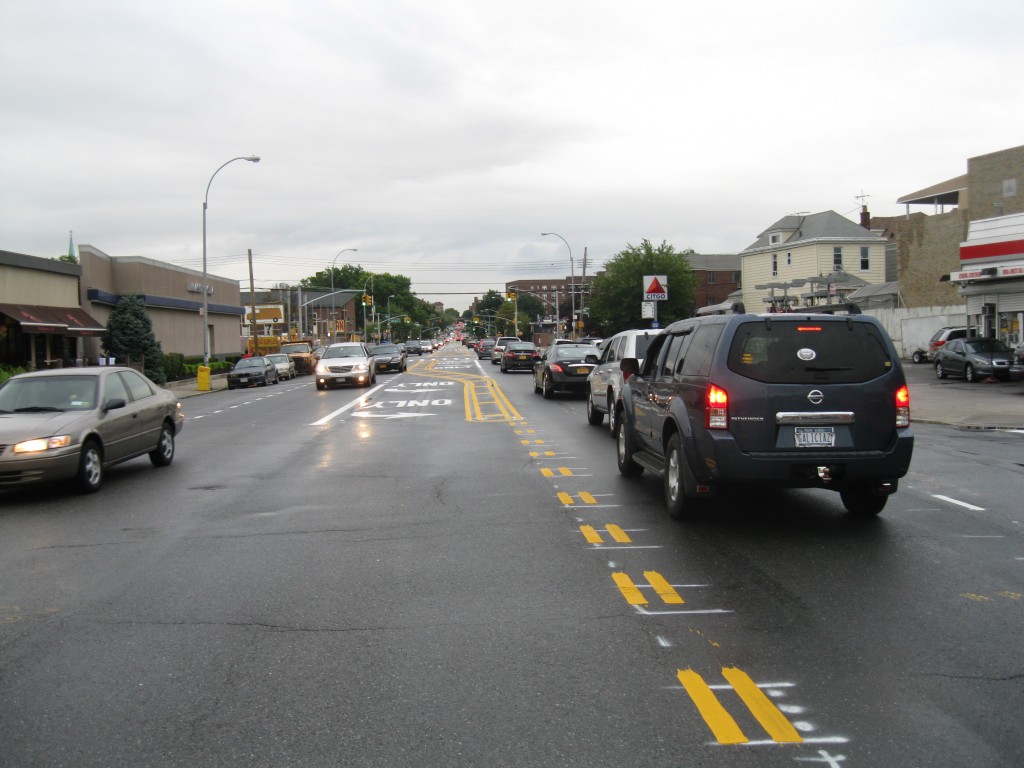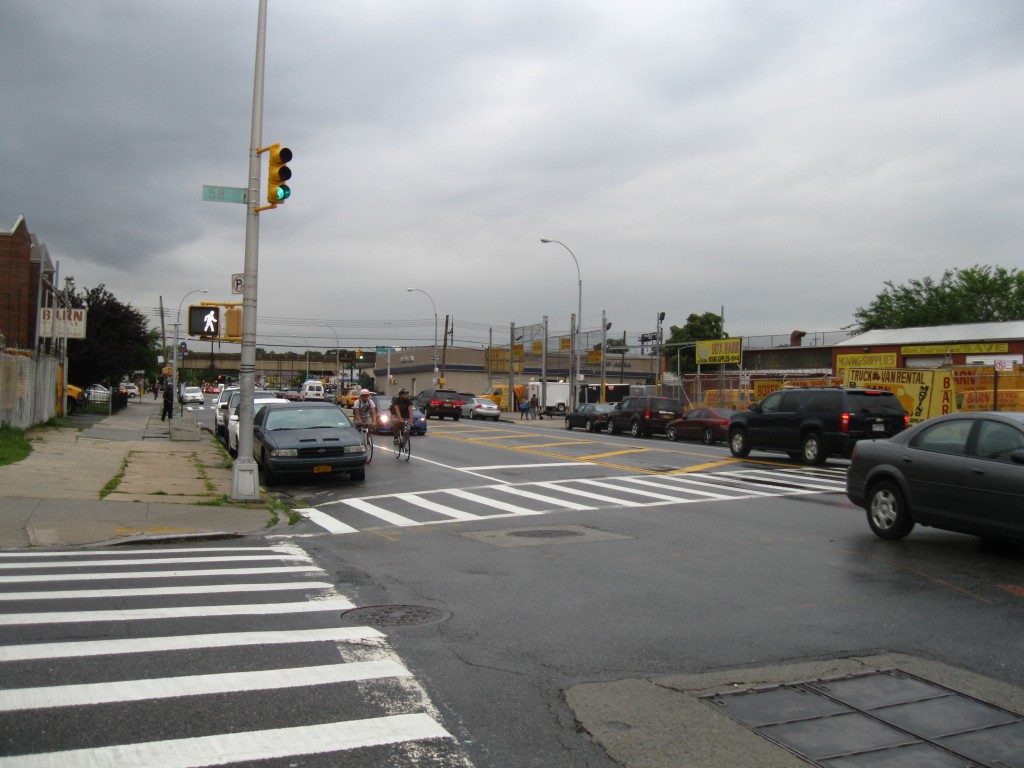“Et si on commençait par élargir les trottoirs, Madame Hidalgo?” December 8, 2014. Le Monde. By Olivier Razemon, translated by Angus B. Grieve-Smith. View the original post for full-size images.
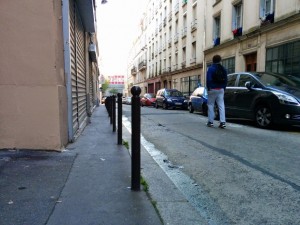 Banning diesel vehicles, partially pedestrianizing the four central districts, bike paths, routes dedicated to “environmentally friendly” vehicles… The Mayor of Paris seems to have realized the danger that air pollution poses to people who spend time in the Paris region, whether they live there or not (details here).
Banning diesel vehicles, partially pedestrianizing the four central districts, bike paths, routes dedicated to “environmentally friendly” vehicles… The Mayor of Paris seems to have realized the danger that air pollution poses to people who spend time in the Paris region, whether they live there or not (details here).
These steps, which will be debated at upcoming City Council meetings, will be attacked by various lobbies and may become a political football. Anne Hidalgo knows a thing or two about that. Her Tour Triangle project was defeated last november by an ad hoc coalition in the chamber. The next round of residential parking rate increases, which the administration is quietly promoting, is still being debated by the ruling coalition. City Hall is worried that the Communist city council members will refuse to touch it, perceiving it as an attack on low-income households.
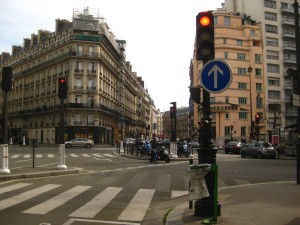 Discouraged pedestrians. So to bring down pollution, but also noise and frustration, while easing commutes, what if we started by widening the sidewalks? When you think about the street space available, when we encourage one mode of transportation, in this case walking, we discourage the others. Take a look at the photo above. To cross the intersection you’d be better off on a motorcycle than trying on foot. Pedestrians deserve better: according to a study by Insee, half of all trips in the capital are made on foot.
Discouraged pedestrians. So to bring down pollution, but also noise and frustration, while easing commutes, what if we started by widening the sidewalks? When you think about the street space available, when we encourage one mode of transportation, in this case walking, we discourage the others. Take a look at the photo above. To cross the intersection you’d be better off on a motorcycle than trying on foot. Pedestrians deserve better: according to a study by Insee, half of all trips in the capital are made on foot.
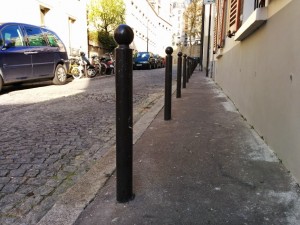 A little strip of asphalt. In small streets, a sliver barely a meter wide is left for pedestrians, whether they’re traveling solo, with others, with a stroller, in a wheelchair, or pulling a suitcase. The lane is wide enough that a speeding car or motorcyle can terrorize passersby, sending them running for their little strip of asphalt.
A little strip of asphalt. In small streets, a sliver barely a meter wide is left for pedestrians, whether they’re traveling solo, with others, with a stroller, in a wheelchair, or pulling a suitcase. The lane is wide enough that a speeding car or motorcyle can terrorize passersby, sending them running for their little strip of asphalt.
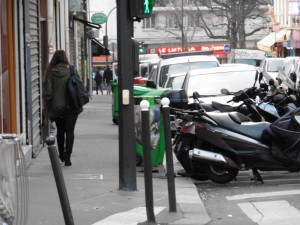 King Bollard. Bollards, metal ones in particular, are installed to prevent sidewalk parking, but wind up limiting the movement of pedestrians. But that’s not all: green trash cans, angle-parked motorcycles, café tables and chairs, loose trash, yellow trash cans, and so on. There’s a lot going on on a Parisian sidewalk.
King Bollard. Bollards, metal ones in particular, are installed to prevent sidewalk parking, but wind up limiting the movement of pedestrians. But that’s not all: green trash cans, angle-parked motorcycles, café tables and chairs, loose trash, yellow trash cans, and so on. There’s a lot going on on a Parisian sidewalk.
 All it takes is one irritant. In a lot of our streets, particularly at certain times of day, pedestrians have no choice but to walk in the street. This is not always dangerous, because drivers slow down automatically, but it’s inconvenient for everyone. A single car on a quasi-pedestrian street can upset fifty pedestrians, just like a single train passenger yelling into a cell phone at the expense of everyone else’s peace and quiet.
All it takes is one irritant. In a lot of our streets, particularly at certain times of day, pedestrians have no choice but to walk in the street. This is not always dangerous, because drivers slow down automatically, but it’s inconvenient for everyone. A single car on a quasi-pedestrian street can upset fifty pedestrians, just like a single train passenger yelling into a cell phone at the expense of everyone else’s peace and quiet.
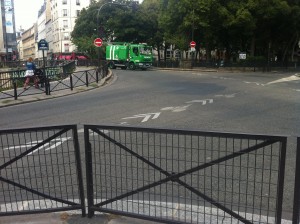 Like a racetrack. For pedestrians it is impossible to cross certain intersections in one light, thanks to barriers placed by the city. What you see in the photo above sends the message: Streets are sacred, like a racetrack, no trespassing. When we install these protections we forget that people who move with their bodies like to move fast too. If we freed pedestrians from the confines of these sidewalks we would at the same time cut down on the speed of cars, and eventually on unnecessary car use.
Like a racetrack. For pedestrians it is impossible to cross certain intersections in one light, thanks to barriers placed by the city. What you see in the photo above sends the message: Streets are sacred, like a racetrack, no trespassing. When we install these protections we forget that people who move with their bodies like to move fast too. If we freed pedestrians from the confines of these sidewalks we would at the same time cut down on the speed of cars, and eventually on unnecessary car use.
 Let’s talk business. On the Grands Boulevards, in many places, there is still a lane across the sidewalk to allow drivers to access the parking areas. Sure they do it slowly, but they push pedestrians aside, behind bollards. And this hurts businesses! Despite what you may hear from developers, and even from some business people, the best customers for local businesses are pedestrians and cyclists. They may buy less per visit, but they shop more often – as long as they feel comfortable on the street.
Let’s talk business. On the Grands Boulevards, in many places, there is still a lane across the sidewalk to allow drivers to access the parking areas. Sure they do it slowly, but they push pedestrians aside, behind bollards. And this hurts businesses! Despite what you may hear from developers, and even from some business people, the best customers for local businesses are pedestrians and cyclists. They may buy less per visit, but they shop more often – as long as they feel comfortable on the street.
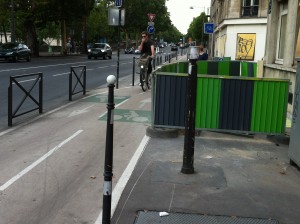 Sidewalks erased. Sometimes when people are doing construction they will close the sidewalk, but not the bike lane. You might think they do it on purpose, to set up the kinds of conflicts so beloved by the tabloids. This might be a good place to note that in calmer cities dedicated bicycle infrastructure is no longer necessary: bikes ride in the street, leaving plenty of space on the sidewalk for pedestrians.
Sidewalks erased. Sometimes when people are doing construction they will close the sidewalk, but not the bike lane. You might think they do it on purpose, to set up the kinds of conflicts so beloved by the tabloids. This might be a good place to note that in calmer cities dedicated bicycle infrastructure is no longer necessary: bikes ride in the street, leaving plenty of space on the sidewalk for pedestrians.
 That pointless barricade. Sometimes we just can’t figure out the rationale behind certain installations. In the above photo, at the exit of the Colonel-Fabien metro station, this little barricade obstructs the flow of people leaving the metro and waiting to cross the street. What is the point of this piece of steel? There must once have been one, but it has been forgotten by everyone, including the transportation department.
That pointless barricade. Sometimes we just can’t figure out the rationale behind certain installations. In the above photo, at the exit of the Colonel-Fabien metro station, this little barricade obstructs the flow of people leaving the metro and waiting to cross the street. What is the point of this piece of steel? There must once have been one, but it has been forgotten by everyone, including the transportation department.
